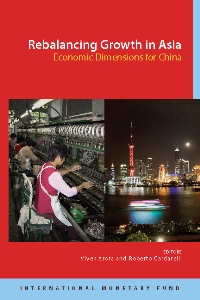The center of global economic growth is moving from the West to Asia, in particular emerging Asia and China.
 But, left unattended, the economic imbalances that have emerged with this shift in power could test the sustainability of global growth.
But, left unattended, the economic imbalances that have emerged with this shift in power could test the sustainability of global growth.
How to achieve this rebalancing is a key theme of a new book from the IMF, launched in Hong Kong, on Rebalancing Growth in Asia—Economic Dimensions for China.
Sources of Asia’s growth
Over the last 30 years, the Asian economy has grown by over 7 percent each year. In other words, it has doubled in size every decade. This success has been based in large part on outward oriented growth strategies—giving market forces greater play and encouraging the production of tradable goods have been common themes. China’s “reform and opening up” policy, launched in 1978, is perhaps the most prominent example.
Over time, however, awareness has grown that export-led growth needs to be balanced by a second engine of growth.
- Heavy reliance on exports has contributed to a sharp rise in external current account surpluses in recent years from broadly balanced positions in the 1980s and 1990s.
- And the global financial crisis has underscored the urgency of this transformation, reminding us that outward oriented growth has left Asia vulnerable to swings in global demand.
Stronger domestic demand, and in particular private domestic demand, is the second engine of growth that would help to address these imbalances and reduce undue reliance on external demand.
How then to raise domestic demand?
First of all, rebalancing will mean different things for different countries as the reasons for relatively weak domestic demand vary across the region. In China, low private consumption as a share of GDP is a major factor, but in other economies it is private investment that has been low since the late 1990s. Therefore, policies will also need to differ across countries. An important issue is financial sector reform. Improved access to financial services can facilitate the rebalancing process by boosting household consumption, or alleviating constraints faced by firms, in particular smaller ones and those seeking to invest in the services sectors.
Second, China more specifically faces a number of challenges in rebalancing growth. Turning away from export-oriented growth could lead to job losses in the short term, but employment would actually rise in the longer-term as more jobs are being created in the domestic-demand oriented sectors. On the demand side, weak consumption, or high household saving, in China is not somehow preordained by culture. Instead, it may be responsive to policies, including higher public spending on health or improving access of households to financial services.
Finally, a sustainable global recovery will also depend on how we manage to reduce social imbalances. In Asia, the recovery has not been as “jobless” as it has been in some other parts of the world, but inequality and a lack of social safety nets are concerns across many emerging economies in Asia. In fact, as the book shows, better provision of social services could play a critical role in boosting household consumption in China.
Will rebalancing work?
To be sure, rebalancing will take time and policies will need to be comprehensive and tailored to country-specific circumstances.
But, if Hong Kong’s successful transformation from a small-scale manufacturer to a global logistics and finance hub can teach us something, it is that we should embrace changes that make our economies more sustainable.



